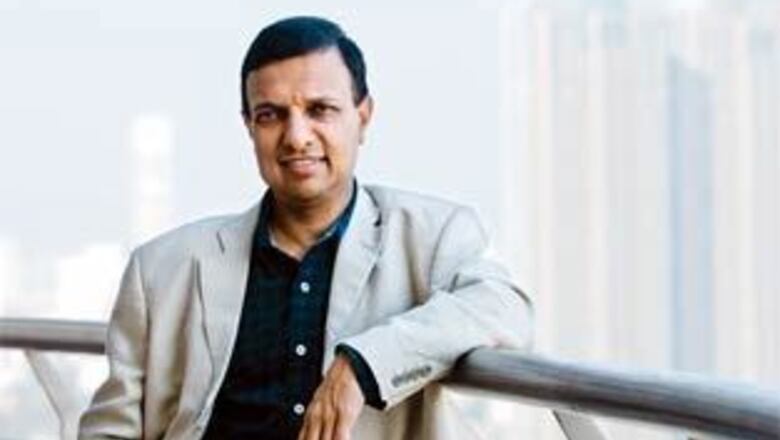
views
Nachiket Mor must have felt the hands of destiny on the day he was named. His namesake in Katha Upanishad swapped the promise of worldly wealth, power and glory for the knowledge of life after death.
Two years ago, Mor, long seen as the crown prince of ICICI Bank, India's largest private lender, opted out of the race for the corner office to pursue an obscure goal as the head of its social service arm. He disappeared from the corporate scene. The talk was that he had shifted base to Thanjavur, a town often known for a thousand-year-old temple in Tamil Nadu.
Even today he is not really back. He prefers development seminars to press conferences. When journalists ask him about his work, he answers modestly. "It's still too early," is his usual refrain.
Yet, it's important to know what Mor had been doing since he left ICICI Bank, for two reasons. First, some of ICICI Foundation's work in health and education is already having an impact. Most non-profits can claim that. But, "there is a big difference between what ICICI Foundation does, and what a typical non-profit organisation does," says Education Secretary of Chhattisgarh, Nand Kumar, who has partnered with Mor. Second, his work in Thanjavur (as the chairman of IFMR Trust, an arm of a Chennai based business school) might turn out to be the next big idea in rural finance.
In 2007, when ICICI Bank formed ICICI Foundation to streamline its corporate social responsibility (CSR) activities, Nachiket Mor offered to lead the initiative. It surprised many. But for those who knew him, the dots connected. After all, he spent his impressionable years at Brockwood Park, a school founded in the UK by philospher J Krishnamurti.
Even at ICICI Bank, his interests had gone beyond the core business. A former ICICI Bank staffer, Anil Kumar, who now works for IFMR Trust, recalls that Mor closely tracked his work in rural finance, "even though there were several levels between me and Dr Mor."
With an organisation to call his own - and with a commitment of 1 percent of ICICI Bank's profit towards its budget - Mor did not go around building a big team. He put together a six-member team and put it to work with partners in health and education (and financial inclusion, civil society and environment).
Partnerships mean the foundation doesn't get bogged down by its way of doing things, but incorporates best practices, Director of Schoolscape, Amukta Mahapatra, who has observed ICICI Foundation's work in education, says. "What they have to do then is to share their learnings with others."
Similarly, Chattisgarh's Nand Kumar says that most non-governmental organisations tend to focus on a few locations and are too obsessed with short-term outcomes. But, ICICI Foundation works on pilot projects with the government, and helps the government roll them out in a bigger scale. It focusses on lasting transformation. "The impact tends to be much bigger."
PAGE_BREAK
"If you want a parallel, our aspiration would be to be a McKinsey for the development sector," Mor says. But there is a difference. "The pilots we do on the ground are large. We don't stop at advice. We work at it until the result happens."
Few deny that primary health and education - mostly in the domain of government and NGOs - need a more rigorous approach, in design and in implementation. Abhijit Banerjee, an MIT economist, says that many policies are based on zero evidence. "Development efforts would yield much better results with at least some evidence," he says. Besides, some programmes, even if they are not perfectly designed, will improve things on ground, if only they were implemented well.
This is where Mor comes in. To help the government with ‘what' and ‘how'. His organisation would bring an evidence-based, research-driven approach to find out what works. It will then show the government, how it will work. "Our focus is on government-provided health and government provided- education. The question is how you make the delivery happen," he says.
Mor's critics would argue that he is probably not the best person to ‘make the delivery happen'. He tends to evoke descriptions like ‘academic' and ‘ideas man'. His resume can pass off as that of a professor, starting with his Ph.D at Yale and ending with a list of published works. At one point during an interview for this article at his Chennai office, Mor leapt out of his chair to reach a white board and drew a chart based on an 1960s academic paper to show what financial inclusion means. Even for his admirers, he is predominantly an ideas man. "You speak to him for one hour, and he will give you enough ideas to think about for ten days," says a colleague.
At times, he could even seem a little out-of-world (A Haiku on his twitter page: "Icy mountain pass / Deep blue sky / Pure white snow / Perfect place to die"). There is little doubt that his is a mind that connects the lofty idealism of a poet with the academic rigour of a scholar. The question is whether it also includes the pragmatism of a businessman.
One answer is that the world of ideas and academics could have answers for the problems that bog the development sector. Executive Director of National Health Systems Resource Centre, T Sundararaman, recalled a session with Mor a while ago. "I was so impressed with the way he asked questions. They were so sharp, incisive. The questions themselves brought a lot of clarity. They added a lot of value," he said.
And then again, Mor himself has dirtied his hands since he left the bank. CEO of Azim Premji Foundation, Dileep Ranjekar, who had seen Mor in Wipro board, met him in Thanjavur recently. "In some ways, he was the same. But he had changed too. He seemed to be more grounded," Ranjekar said.
Beyond Microfinance
Mor's work in Thanjavur, though not connected to ICICI Foundation, could give a clearer idea of his approach to development. (Mor is quick to give the credit to the team at IFMR Trust for all the work. And IFMR Trust, in turn, gives all the credit to Mor). Here, Mor took on a problem that has been vexing the policy makers for long: how to take finance to the poor.
PAGE_BREAK
The popular answer is micro finance, giving small loans without any collateral, to groups of people. It has transformed a lot of lives and earned its pioneer the Nobel. More importantly, the model got the stamp of capitalist approval, with venture capital chasing micro-finance institutions and MFIs contemplating IPOs.

But there are issues with micro finance. To be successful, an MFI has to spread thin (because it typically targets only 10 percent of the population in a village), has to sacrifice customisation in favour of standardisation of products and processes, says President of IFMR Trust, Bindu Ananth. Microfinance has a role to play, but it's not the answer to financial inclusion. Mor thinks he has one.
Mor did not discover the answer when he went around Thanjavur. He already had an idea. In a 2005 article in Economic and Political Weekly, he had suggested local financial institutions for credit delivery. But, in villages around Thanjavur (with evocative names such as Karambayam, Alakkudi, Orathur and Varagur) the rubber would hit the road. In the form of KGFS, Kshetriya Grameen Financial Services.
Alakkudi is a typical village in the district with unpaved roads, a small railway station, church, temple and not a single bank in the five-kilometre vicinity. KGFS' branch there is a typical example of Mor's answer to micro finance institutions.
On a recent Friday afternoon, there were a dozen customers in the branch. Some had come to get more loans. One prospective customer was being photographed before being sent to a biometric scanner for his thumb impression. A dot of red light flickered from a burglar alarm on the wall. Some school kids queued outside to take a sip of purified water. The staffers were dressed in grey and black, with KGFS logo embroidered on their shirts.
A typical MFI would scoff at such a branch. The cost would be prohibitive. But, KGFS hopes to gain from "economies of scope," offering a range of products - loan, insurance and investments - to a large base of customers. IFMR Trust is designing some of them. Its wealth managers - the core of KGFS model - will offer relevant products to customers, much like a physician prescribing medicines based on specific needs of a patient. It's banker as a physician. Again, this idea is not entirely new. "That's what we do in corporate banking," Mor says.
PAGE_BREAK
What was new was converting ideas (gleaned from models across the world) and practices (learned as a banker) in the dirt and dust of rural India. To do that, Mor spent a lot of time in Thanjavur over six months. He rented a house. ("It was a nice, little, cozy place. It was painted white, and we used to call it the White House," a colleague who worked with him then said.) He travelled widely in the district. ("It's amazing how diverse the financial needs can be even within a state. Nagapattinam, just three hours drive from Thanjavur, can be so different," said another colleague who traveled with him). He discussed, for hours, and refined the strategy. ("Most of our strategy discussions were held right here," said Anil Kumar, sitting in a restaurant at Hotel Sangam in Thanjavur). And then, there was implementation. ("What turned out to be a lot tougher was training the wealth managers," says Bindu Ananth).
KGFS is still an experiment. Once the pilot is complete - lesson learned, processes refined, training modules perfected - IFMR Trust would offer the model to other entrepreneurs as a package. It's not too different from the kind of approach that ICICI Foundation has taken for health and education, except in two ways. KGFS would be a for-profit venture, and the replication would be done by entrepreneurs. (IFMR Trust would have built a consulting firm specialising in rural finance, offering its expertise for a fee). ICICI Foundation's work, on the other hand, is strictly non-profit, and it would depend on the government to replicate its pilots. (It would be a consulting firm too, offering its expertise free).
For ICICI Foundation, this approach has met with initial success. In Mumbai, its partner ICICI Centre for child health and nutrition, worked with BMC (Brihanmumbai Mahanagar Palika) to bring down deaths during and just after child birth in some slums by upgrading facilities, providing training and using communities. The model is now being implemented across the city. In Jharkhand, it sought to reduce low birth weight incidence - by setting up Village Health Committees (VHCs) and hamlet-based voluntary health workers (Sahiyyas) to improve access to health services. The results, again, were good enough for the government to roll out the main elements of the project across the state.
The job ahead would be similar to what a McKinsey would do to spread its influence. Convince clients to use its services. In this case, make the government see its expertise and the virtue of its interventions. And that's not going to be easy. Bureaucrats have traditionally resisted change across the world. It will take all of Mor's intellect and charm to bring the politicians and bureaucrats on his side. Then, implementation challenges: What is successful in one state might fail in another. Mor is only too aware of it.
How will we ever know if he ever got what he had set to achieve? We will never know that in clear terms as in world of business – no net profits, no market shares, and no stock prices here in the world of development. But that should not worry us too much. When grappling with ways to measure the wealth of the poor, Bindu Ananth likes to repeat Mor's favourite quote: ‘It's far better to inaccurately measure something you care about, than to accurately measure something that you don't care about.'
It might help to remember that in, Katha Upanishad, Nachiketas declined the offer of land and cattle – all measurable - and opted instead for knowledge about life after death – not so easy to measure.

















Comments
0 comment